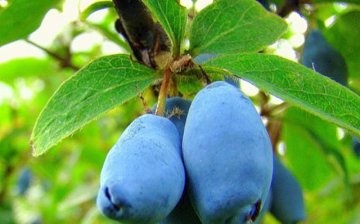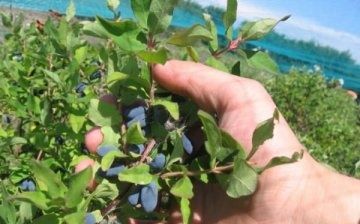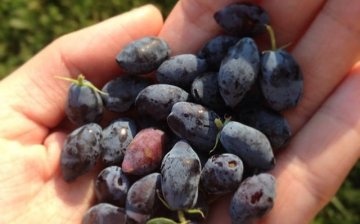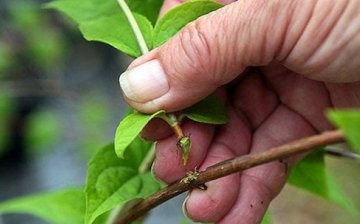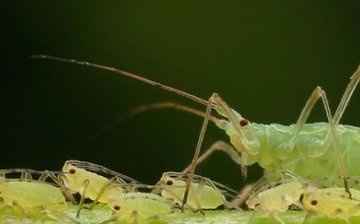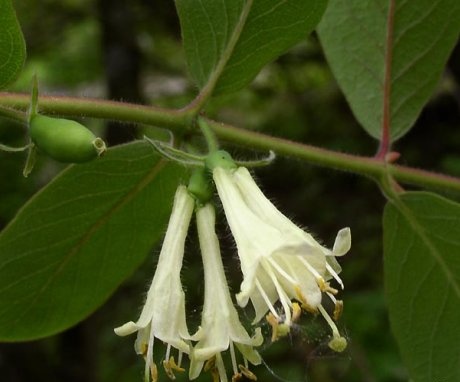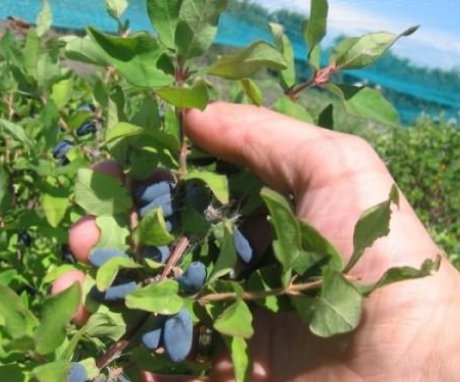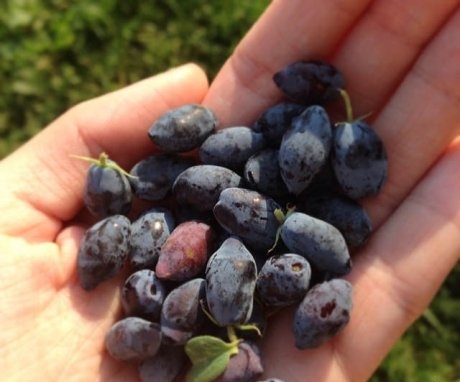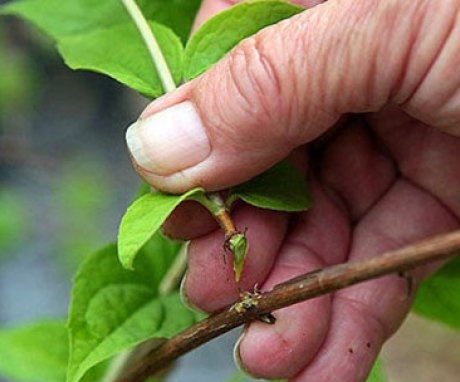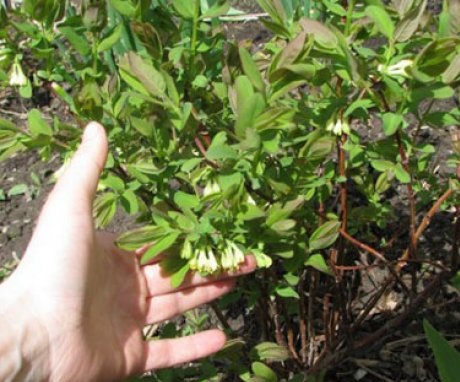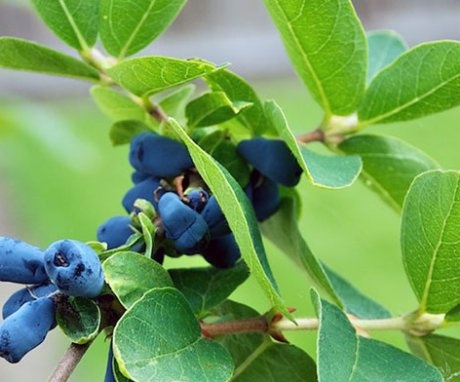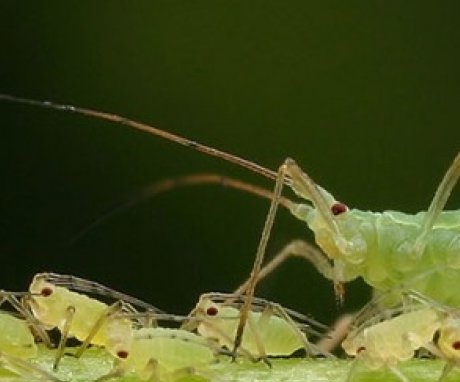How to propagate honeysuckle? - Ways and rules
Honeysuckle wakes up from hibernation earlier than other shrubs. Its fruits are rich in vitamins C, B group and rutin. This beneficial plant will not only decorate the summer cottage, but also give health. At the same time, caring for honeysuckle is very simple.
Honeysuckle is a very interesting plant. Its growing season starts at a temperature of only three degrees Celsius, and the bush blooms at nine. At the same time, honeysuckle is not afraid of sudden frosts. However, the amount of the harvest depends on the weather conditions: if there is heat and drought, the flowers will fall off ahead of time. And in rainy and windy weather, full-fledged pollination does not take place, because bees do not fly.
Content:
- What is honeysuckle
- How can a shrub be propagated
- Propagation using seeds
- Propagation by cuttings
- Reproduction by layering and dividing the bush
- How to provide proper plant care
- Who and what can threaten honeysuckle
What is honeysuckle
As a berry bush, honeysuckle was entered in the State Register in the eighties. Prior to this, the plant was considered a weed with unpleasant, sour-bitter fruits. However, thanks to the efforts of breeders, today many varieties of honeysuckle have been bred, which gives not only tasty, but also very useful berries for the body.
Today, more than a hundred varieties of honeysuckle are known, and most of them are bred by Russians. The berries of this plant are rich in vitamins and minerals. They contain ascorbic and organic acids, flavonols, catechins, anthocyanins and pectins.
Honeysuckle is a shrub with climbing, creeping or erect shoots.
The plant owes its name to the German scientist Adam Lonitzer. However, Karl Linnaeus called her honeysuckle. As an ornamental crop, honeysuckle in gardens is usually presented in two varieties: edible and blue (blue):
- Features of edible honeysuckle (Lonicera edulis). This variety is represented by a deciduous shrub that can reach a height of one meter. The bush is formed by young thin green, sometimes with a lilac shade, shoots. Old branches are bare and thickened, covered with brownish-yellow bark. The leaves grow up to seven centimeters in length and are covered with a small fluff, which is lost with age. In the axils of the leaves, funnel-shaped flowers of a yellowish tint are formed in pairs. After flowering, oval dark blue berries are tied, covered with a bluish bloom. Inside, the fruits are reddish-lilac with small brown seeds.
- Features of blue (blue) honeysuckle (Lonicera caerulea). A woody deciduous shrub grows up to 2-2.5 meters. A neat crown is formed from upright curved shoots covered with brownish bark with a grayish or reddish tint. Leaflets on short petioles are opposite. Yellowish, similar to bells flowers form inflorescences. Elliptical berries are dark blue in color, with a gray bloom. It tastes sweet with bitterness.Honeysuckle is characterized by rapid growth and long fruiting period (80-130 years).
Shrubs cannot self-pollinate, therefore, for the formation of fruits, several representatives of the culture are needed so that the bees can cope with their task.
How can a shrub be propagated
There are several methods available for breeding honeysuckle:
- seminal
- through cuttings
- dividing a bush
- layering
Each method has its own advantages and disadvantages. It is very easy to propagate the plant by seeds, however, in this case the parental qualities are not preserved and the offspring are of lower quality.
The most popular propagation methods are cuttings and using layering.
The seed method is common among breeders. The division of the bush can be applied no earlier than six years later, and it is difficult to propagate a fifteen-year-old plant in this way.
Propagation using seeds
When using this method, it is impossible to guess what the berries will taste like and how abundantly the plant will bear fruit. Several methods are used for the extraction of seed:
- The largest and ripe fruits are selected. They are squeezed out, and the collected the seeds placed in water. After a while, the seeds will settle, and the skin particles will float up and can be removed.
- The berries are rubbed through a sieve, washed and dried.
- The fruits are laid out on a thin sheet of paper that absorbs moisture well. Juice is squeezed out and dried. Then it is wrapped and stored in a warm, dry place until sowing.
Early varieties of honeysuckle can be sown immediately after harvest, directly into the soil or in separate containers. Due to the rapid growth, several pairs of leaves will form in the fall. For the winter period, young bushes should be covered.
Spring sowing, which is carried out in March or April, will be more effective.
Before sowing, the seeds are soaked in a weak manganese solution. For germination of honeysuckle, light fertile soil is prepared by mixing humus, peat and sand in equal amounts. Seed material is laid out on top of the ground and sprinkled with sand. Seedlings should be covered with plastic or clear plastic to maintain proper moisture and warmth.
Crops should be regularly moistened, and irrigation should be done very carefully so that the seeds are not washed out of the soil. The first borings will appear in about a month. Next year plants transplanted to the prepared place, observing an interval of five centimeters.
Propagation by cuttings
Up to two hundred cuttings are extracted from one honeysuckle bush. Moreover, you can use both green and lignified cuttings.
When using lignified cuttings, the material is harvested in early spring - before the buds bloom:
- To do this, choose annual shoots, the thickness of which should be at least a centimeter and cut into fragments of 20 cm.
- After the soil has moved away from the winter frosts, the cuttings are planted in greenhouses, deepening a few centimeters. In this case, it is necessary to ensure that at least a pair of upper buds remain above the ground.
- Planting is covered for better rooting, which lasts about a month.
- Follow-up care consists of regular watering and maintaining the temperature.
When using green cuttings, the material should be taken when green berries appear:
- You should choose such branches that break easily when bent. You need to cut the cuttings in the morning, while it is not hot. The central parts of the shoots are suitable for this. Each fragment must have at least two eyes and one internode.
- The upper cut should be straight and one and a half centimeters above the kidneys, and the lower cut at an angle of 45 degrees. The leaves are removed from the lower part, and the upper ones are shortened by half.
- After cutting, the cuttings are immediately planted in prepared soil, which is prepared by mixing peat and sand (1: 3).For successful rooting, it is necessary to maintain high humidity in the air and soil. The optimal temperature is considered to be 20-25 degrees.
- The first roots will appear in 1-1.5 weeks. It is at this moment that you need to start hardening, airing the greenhouse for 25-45 minutes. The airing time is gradually increased, at the same time teaching the spraying.
- A transplant to a permanent place is carried out in the second year in the spring, and from the third year, individual representatives begin to bloom and bear fruit.
Reproduction by layering and dividing the bush
It is fairly considered the simplest method. To implement it, it is enough to loosen the soil under the bushes in the summer and bend healthy annual branches, fixing them to the surface of the earth. After that, the shoots are sprinkled with earth at several points and watered throughout the season.
The next year, the rooted layers are separated from the mother bush and transplanted. Two years later, new bushes will grow honeysuckle.
Bush division - this method is used both in autumn and spring.
The bush, which has already reached the age of six, needs to be dug up and divided into several parts and planted in prepared places. The cut sites must be treated with a disinfectant solution.
How to provide proper plant care
Honeysuckle refers to unpretentious crops and to ensure a comfortable existence, you should adhere to simple rules:
- Pruning... The procedure should be carried out in autumn or spring. Weakened and damaged branches are subject to removal. Old honeysuckle should be rejuvenated by cutting off the entire plant, half a meter from the ground.
- Top dressing should be carried out twice a year using organic and mineral fertilizers.
- Irrigation. Water the honeysuckle sparingly. However, during the ripening period of berries, if the weather is hot, dry, the intervals between watering are reduced by increasing the amount of water. This is necessary so that the berries do not become bitter and the amount of the harvest does not decrease.
- When the crop is harvested, the faded shoots are cut in half, and the bushes are treated with Bordeaux liquid. Such measures will protect the plant from fungal infections that weakened honeysuckle is susceptible to.
Who and what can threaten honeysuckle
An unpretentious plant to care for is rarely exposed to diseases and attacks of insect pests. But you still need to know what to do if the condition of honeysuckle has worsened.
- The leaves turned yellow. The plant was attacked by honeysuckle aphid... To combat, tobacco, garlic or pepper infusions are used. If necessary, use systemic insecticides.
- Pliers. Tick damage occurs with heavily thickened plantings. The leaves are covered with dark spots and soon dry up. The fight consists in thinning bushes and chemical treatments.
- Fingerwing. May spoil unripe fruits. If a pest is found, the planting should be immediately treated with infusions from the foliage. tomato and potatoes... In case of mass destruction, chemical treatment is carried out.
- Powdery mildew... When this disease is affected, a whitish bloom appears on the leaves. Treat the plant with insecticides or wood ash.
- Phytoviruses. Pale green spots form on the leaf blades, and dark blotches along the veins. This disease is not amenable to treatment, and in order not to infect the entire garden, diseased bushes are dug up and burned.
Providing the plant with comfortable living conditions, with little effort, you can achieve a high yield of healthy and tasty berries that will keep the whole family healthy. Honeysuckle is a very grateful and generous plant that is easy to plant and propagate.
More information can be found in the video:



